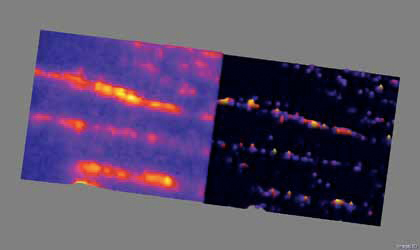Christopher Yip
PhD

Qualification
- University of Minnesota, Minneapolis, MN, U.S., PhD in Chemical Engineering and Materials Science, 1996.
- University of Toronto, BASc in Department of Chemical Engineering and Applied Chemistry, 1988.
OTHER AFFILIATIONS
- Department of Chemical Engineering and Applied Chemistry, University of Toronto.
MY RESEARCH OVERVIEW (GO TO SCIENTIFIC OVERVIEW)
Single Molecule Biophysics and Combinatorial Microscopies
Form follows function. This is not just an axiom for architects and industrial designers. My lab is interested in how molecules assemble to form unique architectures, structures, and how these structures relate to their function. Such insights, obtained at the single-molecule scale, are critical to understanding biological mechanisms and dynamics.
Our lab is unique in that we focus our efforts on examining these interactions at the single-molecule scale, using a combination of high spatial/temporal resolution imaging (drawing from new advances in nanotechnology) and high performance computational simulations that allow us to examine the dynamics of molecules at the atomic-scale. We are particularly interested in membrane proteins and interactions at membranes. Our work will advance understanding in a number of areas, including how toxins act on cells, how cells communicate, and how membrane dynamics are influenced by specific molecular events and processes.

By being part of the Donnelly Centre, my lab gets to take advantage of the great interdisciplinary aspect of the building. We have the chance to interact with other researchers with whom we would not normally be in contact. Bringing all these people together in a single location, and facilitating their interactions, is key to advancing all of our research projects. Our lab is particularly interested in the design of novel biophysical characterization platforms. For instance, my lab has worked with Grant Brown on the design of a new DNA combing machine. With Peter Roy, we are developing new high-throughput imaging platforms for chemical screening. We are actively developing and applying new imaging platforms, including super-resolution, light sheet, and combinatorial scanning probe microscopies for real-time visualization of molecular and cellular dynamics.
SCIENTIFIC RESEARCH OVERVIEW
Understanding and ultimately controlling how molecules assemble into functional structures is critical in fields ranging from materials science and chemistry to structural and cell biology. We have a long-standing interest in understanding the fundamental mechanisms of self-assembly, ranging from the self-association of dye molecules into excitonic structures, to protein and peptide aggregation. Our most recent work has focused on the dynamics of molecular assembly in live cells and specifically how the hetero- and homo-geneous association of membrane receptors impacts cell signaling and cell-cell interactions. Determining the structural and conformational requirements for these complex assembly processes, and the dynamics thereof, is best accomplished by examining these phenomena on the molecular scale, in real-time, and under nominally real-world conditions. We are focused on the design and optimization of combinatorial microscopies for the direct interrogation of molecular and biomolecular self-assembly.
Key projects in our lab include:
- Hyperspectral super-resolution 3-D optical microscopy for tracking sub-cellular dynamics, organelle remodeling, and protein assembly in live cells
- Super-resolution light sheet microscopy for probing cell-cell and tissue dynamics and structures with sub-micron spatial resolution and high temporal resolution
- Super-resolution combinatorial microscopy that combines optical and scanning probe microscopy to characterize molecular and cellular dynamics and structures
- Combinatorial super-resolution infrared spectroscopy-scanning probe microscopy for label-less single molecule determination of molecular structure, conformation, and interactions
- Development and application of optical coherence tomographies and holographic microscopies to examine cellular structures and dynamics, including tissue organization and biofilm structures
These platforms, and other systems in our lab, have unique capabilities for assessing the role of orientation, conformation, and structure on self-assembly over several orders of magnitude in both length and time. Our highly interdisciplinary research program embraces photonics, biophysics, chemistry, cell and molecular biology, and engineering. Trainees are directly involved in the design, optimization, implementation, and modification of unique and innovative imaging platforms, with a specific focus on open hardware and software design.
SELECT PUBLICATIONS
- Mitochondrial Genome Maintenance 1 (Mgm1) Protein Alters Membrane Topology and Promotes Local Membrane Bending. Rujiviphat J1, Wong MK2, Won A2, Shih YL3, Yip CM4, McQuibban GA5. J Mol Biol. 2015 Aug 14;427(16):2599-609.
- Binding of TDP-43 to the 3'UTR of its cognate mRNA enhances its solubility. Sun Y, Arslan PE, Won A, Yip CM, Chakrabartty A. Biochemistry. 2014 Sep 23;53(37):5885-94.
- The mechanism of membrane disruption by cytotoxic amyloid oligomers formed by prion protein(106-126) is dependent on bilayer composition. Walsh P, Vanderlee G, Yau J, Campeau J, Sim VL, Yip CM, Sharpe S. J Biol Chem. 2014 Apr 11;289(15):10419-30.
